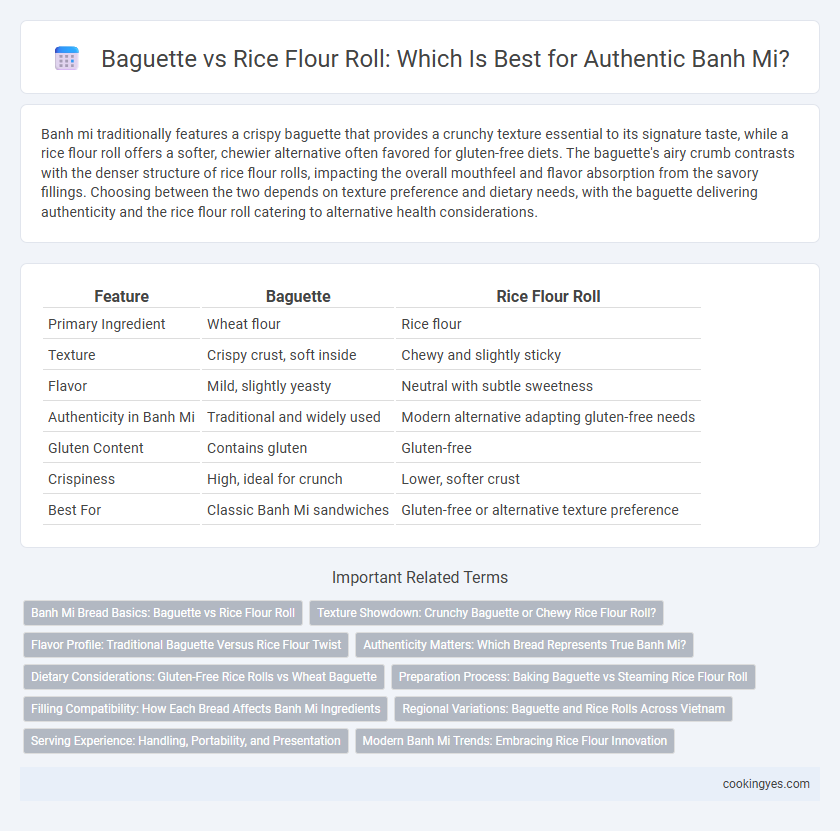Banh mi traditionally features a crispy baguette that provides a crunchy texture essential to its signature taste, while a rice flour roll offers a softer, chewier alternative often favored for gluten-free diets. The baguette's airy crumb contrasts with the denser structure of rice flour rolls, impacting the overall mouthfeel and flavor absorption from the savory fillings. Choosing between the two depends on texture preference and dietary needs, with the baguette delivering authenticity and the rice flour roll catering to alternative health considerations.
Table of Comparison
| Feature | Baguette | Rice Flour Roll |
|---|---|---|
| Primary Ingredient | Wheat flour | Rice flour |
| Texture | Crispy crust, soft inside | Chewy and slightly sticky |
| Flavor | Mild, slightly yeasty | Neutral with subtle sweetness |
| Authenticity in Banh Mi | Traditional and widely used | Modern alternative adapting gluten-free needs |
| Gluten Content | Contains gluten | Gluten-free |
| Crispiness | High, ideal for crunch | Lower, softer crust |
| Best For | Classic Banh Mi sandwiches | Gluten-free or alternative texture preference |
Banh Mi Bread Basics: Baguette vs Rice Flour Roll
Traditional Banh Mi bread relies on a light, airy baguette made from wheat flour, which provides a crisp crust and soft interior essential for supporting savory fillings. In contrast, rice flour rolls offer a slightly different texture, often softer and chewier, appealing to those seeking gluten-free or alternative options without sacrificing taste. The choice between a baguette and rice flour roll ultimately affects the sandwich's structural integrity and flavor profile, highlighting the importance of bread selection in authentic Banh Mi preparation.
Texture Showdown: Crunchy Baguette or Chewy Rice Flour Roll?
Banh mi traditionally features a crunchy French baguette that delivers a crisp, airy texture essential to the sandwich's signature bite. In contrast, rice flour rolls offer a chewy, denser alternative with a moist, glutinous mouthfeel that complements savory fillings differently. The textural showdown between a crispy baguette and a soft rice flour roll highlights how flour composition directly impacts Banh mi's overall sensory experience.
Flavor Profile: Traditional Baguette Versus Rice Flour Twist
The traditional baguette used in banh mi offers a crisp crust and airy interior that balances savory fillings with a subtle wheat flavor. Rice flour rolls introduce a softer texture and a slightly sweet, neutral taste that enhances the freshness of herbs and pickled vegetables without overpowering the palate. This contrast in flavor profiles highlights the baguette's robust character versus the delicate softness of rice flour, catering to varied preferences for this iconic Vietnamese sandwich.
Authenticity Matters: Which Bread Represents True Banh Mi?
The authentic Banh Mi is traditionally made with a light, airy baguette that combines French baking techniques with Vietnamese flavors, characterized by a crispy crust and soft interior. Rice flour rolls, while gluten-free and softer, lack the distinct texture and flavor balance that defines true Banh Mi. For an authentic experience, the classic wheat-based baguette remains the essential bread that represents genuine Banh Mi heritage.
Dietary Considerations: Gluten-Free Rice Rolls vs Wheat Baguette
Rice flour rolls offer a gluten-free alternative to traditional wheat baguettes in Banh mi, catering to individuals with celiac disease or gluten intolerance. While wheat baguettes provide a crispy texture and authentic flavor, rice flour rolls deliver a softer bite and are suitable for gluten-sensitive diets. Choosing rice flour rolls supports dietary inclusivity without sacrificing essential Banh mi flavors.
Preparation Process: Baking Baguette vs Steaming Rice Flour Roll
The traditional Banh mi relies on a French-style baguette baked to achieve a crispy crust and airy interior, using wheat flour and yeast fermentation that requires precise temperature control during baking. In contrast, the rice flour roll involves steaming, which results in a soft, chewy texture without crust formation, relying on the gelatinization of rice starch under moist heat. These distinct preparation methods directly influence the sandwich's texture and flavor profile, with baking developing a crisp shell and steaming preserving moisture and tenderness.
Filling Compatibility: How Each Bread Affects Banh Mi Ingredients
Baguettes offer a crispy crust and sturdy structure that complements and balances rich fillings like pate, pickled vegetables, and savory meats in Banh Mi. Rice flour rolls provide a softer, chewier texture that absorbs sauces and marinades, enhancing the flavors of delicate ingredients such as fresh herbs and grilled chicken. The choice of bread directly impacts the harmony and overall taste experience of traditional Vietnamese Banh Mi fillings.
Regional Variations: Baguette and Rice Rolls Across Vietnam
Banh mi traditionally features a crispy, airy baguette influenced by French colonial bread, especially dominant in southern Vietnam where the texture enhances the savory fillings. In contrast, northern regions often use softer rice flour rolls, reflecting a local preference for delicate, chewy bread that complements lighter ingredients. These regional variations highlight how bread choice in banh mi adapts to cultural tastes and ingredient availability across Vietnam.
Serving Experience: Handling, Portability, and Presentation
Baguette-based banh mi offers a crispy crust and sturdy structure, enhancing portability and ease of handling without compromising the sandwich's filling integrity. Rice flour rolls provide a softer, chewier texture that appeals visually with a glossier surface but may lack the firmness needed for on-the-go consumption. The choice between baguette and rice flour roll directly influences the serving experience, balancing presentation aesthetics with practical convenience for consumers.
Modern Banh Mi Trends: Embracing Rice Flour Innovation
Modern Banh Mi trends showcase a growing preference for rice flour rolls over traditional baguettes, enhancing authenticity with a gluten-free alternative that offers a lighter, chewier texture. Rice flour rolls better complement the delicate, fresh Vietnamese ingredients by maintaining crispness without overwhelming the sandwich's balance. This innovation aligns with health-conscious consumer demands and reflects a fusion of cultural tradition with contemporary dietary trends.
Baguette vs rice flour roll for Banh mi Infographic

 cookingyes.com
cookingyes.com